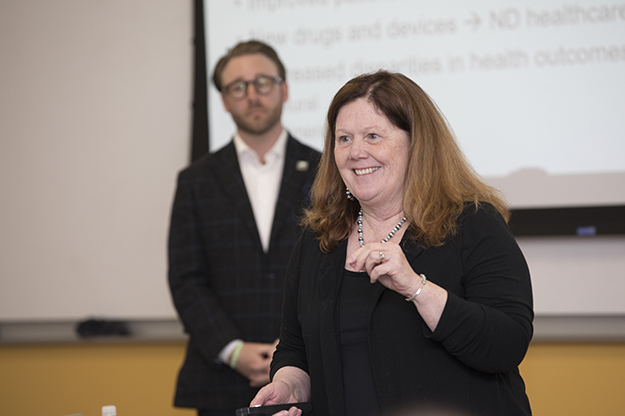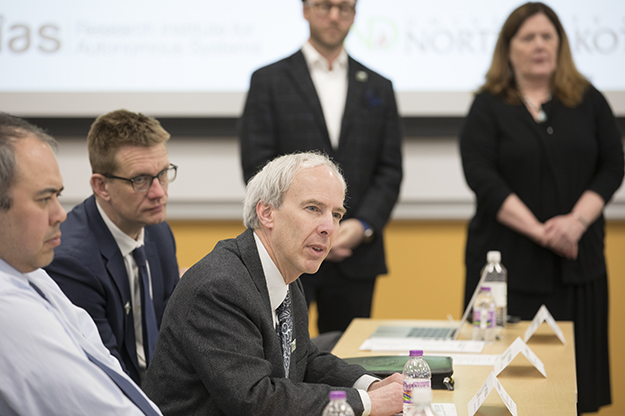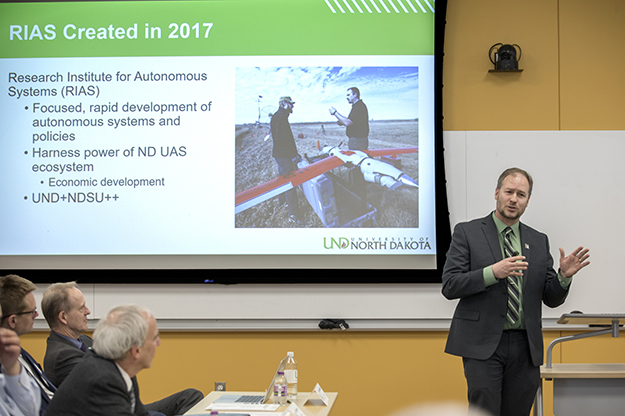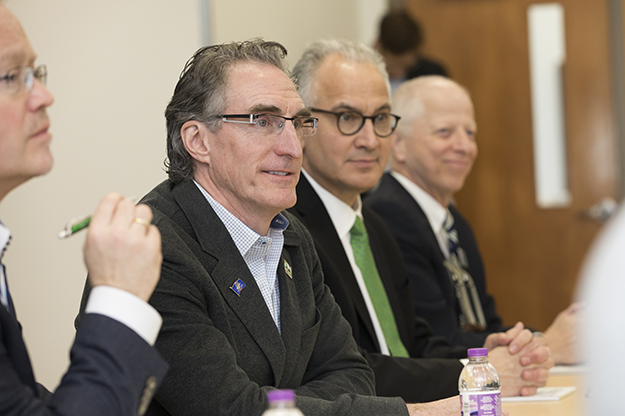Grand Challenges: investments in State’s future
North Dakota Gov. Burgum hears from UND innovators about bold proposals meant to spur meaningful growth

Modest investments could propel state growth, President Kennedy and UND leaders told Gov. Doug Burgum and state leaders when they visited campus Friday.
Burgum and members of his administration toured campus, heard about initiatives, and listened to proposals that UND would like included in the governor’s budget submission for the 2019 legislative session.
Burgum was accompanied by Lt. Gov. Brent Sanford, a UND accountancy alumnus, who was tracking the budget requests.
“Isn’t it comforting to know a UND accounting major is writing down all the requests?” asked Burgum to laughter.
Leaders in industry
UND tied its budget requests to the Strategic Plan Grand Challenges, initiatives that are meant to address state and national challenges in health care, addiction, energy, UAS, data collection and more. In each case, the champions of the Grand Challenges made the case that investments from the state would yield big payoffs in energy development, healthier workforces, more jobs, and economic development. All of the proposals are expected to result in positive returns by leveraging dollars or attracting more money from industry and the federal government.
Leaders in industry, community action and the city spoke in support of the requests.
“The value we see from UND and its initiatives is that they leverage skill sets and attract and grow businesses using the University’s capabilities,” said Tammy Peterson, region president of Bremer Bank. “We can work together to build and grow the economy, and UND is a big factor in growing that economy.”
Barry Wilfahrt, CEO of the Greater Grand Forks Chamber, thanked the state for its investments.
“Grand Forks has a strong track record for return on investment,” Wilfarhrt said. “We can leverage public and private partnerships.”
“It’s terrific to have leaders from across the state support us,” said Tom DiLorenzo, UND Provost.
Burgum said he was impressed with the presentations.
“Thanks to all of you,” Burgum said. “The presentations were crisp, on message, and all tied to a larger strategy. The Grand Challenges look great.”
The presentations were organized by Grant McGimpsey, vice president for research, who introduced each Grand Challenge champion and his or her proposal. More background is available here.

Energy research
“Energy research has impacted jobs, research, and lives in North Dakota,” said Tom Erickson, CEO of the UND Energy & Environmental Research Center. “Lignite coal is more efficient and cost effective today because of the research EERC has done.” Erickson described a number of innovative projects striving to enhance North Dakota energy, including using wind power to manufacture ammonia and the Red Trail Energy Project, which will increase the value of ethanol through carbon sequestration.
Part of the North Dakota Century Code includes a section that, until 2001, funded energy research at UND.
“In 2001 it was converted to a coal testing only program,” Erickson said, advocating reverting the law to include energy research and forming a State Energy Research Center.
For example Erickson said, the EERC has been able to remove more than 90 percent of oil in certain Bakken shales in the lab using CO2 to mobilize the oil out through the pores of the rock.
“We know that rate of recovery won’t happen in the field, but we could significantly increase oil recovery,” Erickson said. He added that a 1 percent increase in oil extraction could yield $3 billion per year.
“We recover just 7 percent of oil reserves in the Bakken now, and it’s cost-effective,” said Burgum. “If we could just double it to 14 percent, that would be massive.”
“Minnkota Power Cooperative is a small generation and transmission cooperative,” said Stacey Dahl, external affairs and communications manager for Minnkota. “We don’t have research and development. We partner with EERC. Carbon capture and increasing oil recovery are exciting and innovative, and a great alignment of resources. The EERC has helped us make our case with the EPA. Lignite is positioned where it is today because of the EERC.”

Focus on health
“Without healthy citizens, nothing happens,” said Marc Basson, senior associate dean for medicine at the School of Medicine & Health Sciences. “We do two things well. We train health care providers and we make new discoveries. What we, nor anyone else in the country, don’t do well is cross the bench-to-bedside chasm, putting research into practice.”
North Dakota faces a variety of health challenges, including Alzheimer’s disease, cancer, substance abuse, an aging population, and difficulty delivering medical care to rural and tribal communities, Basson added.
He advocated partnering with hospitals in the state to perform clinical research and data collection to address those challenges.
“All the hospitals in the state are UND affiliated, and two of every three doctors in the state serve as UND faculty,” Basson said. “There are funding opportunities for clinical trials. We could save hospitals and insurance providers money if we deliver health care more efficiently through partnerships with NDSU that use ‘big data.’”
For example, Basson said, Sanford Health approached UND on a data sharing project. “We found that we can predict mortality and outcomes based on new information that was in their electronic medical records but wasn’t previously known to predict bad outcomes. Using electronic data, we can flag patients who are at high risk. This could lower health care costs, increase survival and lower hospitalizations.”
“This kind of project could attract federal dollars, investments from insurers and save money,” President Kennedy said.
Has the medical school added opioid prescription training? asked Burgum.
“Absolutely,” Basson replied. “We teach that to students in all our programs. Last year we developed a free 10-hour online training program for practicing physicians on opioid use.”
Burgum noted that a recent report graded North Dakota with an F on opioid response.
“That’s not the place to be,” said Burgum.
“We want to earn an A,” replied Basson. “And we can.”
Tackling addiction
Thomasine Heitkamp, a professor in the College of Nursing & Professional Development, focuses on addiction and prevention.
“We can bring an interprofessional approach to addiction,” she said, referring to Burgum’s questions and adding that medicine, social work, nursing, counseling and others must be involved. “Everyone who sees a patient or client has to work together.”
Heitkamp added that North Dakota also has problems with meth and alcohol addiction.
“Our goal is to advance addiction science,” she said. “We have the capacity and have received three federal grants. We are starting to see how to advance the science. We have the space and expertise.”
“We need capacity and technology,” said David Whitesock, chief innovation officer, Face It Together, Denver. “If a community organization had that data capacity and could partner with the University, we could treat in advance and prevent the problem using technology. This would save dollars and reinvent recovery. We can build that at UND.”
“We’re told that west of Highway 83 there is not a single psychiatrist in western North Dakota,” said Burgum. “There are no recovery organizations or counseling. There is nothing out there, and everything seems to be on the eastern side of the state. The west is where we’ve had an influx of population. How can we solve geographic disparities?”
“We can expand tele-psychiatry and tele-mental health,” replied Heitkamp. “It’s hard to get people to move to rural areas, but that and cross training providers can help.”
“We have put some practitioners in rural communities,” Basson said. “You don’t need psychiatrists to deliver care but to be available as backup. We are educating our students in tele-psychiatry now.”
Heitkamp noted that her group is currently receiving $4 million to address the problem, and Burgum complimented her on successfully competing for federal dollars.

Need for speed
Mark Askelson, interim director of the Research Institute for Autonomous Systems (RIAS), spoke about the “need for speed” to serve clients in the military, Department of Defense, FAA and industry.
“RIAS helps combine North Dakota’s many strengths in autonomous systems and UAS to drive economic development,” he said.
Askelson has proposed a rapid response team that could help these entities solve problems. “The University brings a lot of capabilities,” he said, but added there are a lot of contracts and funding the University is not capturing. Such a team would have a high return on investment, he said.
Terri Zimmerman, CEO, of Packet Digital, agreed.
“Significant dollars are spent for autonomous systems in the nation and the world,” Zimmerman said. “We could build RIAS to be one of the largest in autonomous systems in the world.” She added that her corporation does work for Johns Hopkins, Penn State and others, and all are looking for this capability and innovation.
“This is fantastic!” said Burgum. “Total defense spending is $730 billion, and one of the biggest threats we’re facing is to counter UAS.”
“We have met with the National Security Council, DHS and others,” said Zimmerman. “They are all looking for counter UAS technology.” UND needs to be part of that, she added.
“I agree,” said Burgum.
“There is a lot of technology that our group could use,” said Dave Hambelton, senior software engineer with Northrup Grumman. “Given the right state sponsorship and air space, that infrastructure could be useful.“
Zimmerman added that her company has had conversations with the FAA.
“They may be coming to meet with us about drones and potential laboratories,” she said. “North Dakota may be the ideal place for this. It’s getting close to a contract. We need to do more research with RIAS, and we need to have a rapid response.”
“I endorse this,” said Burgum. “We need to move quickly. UND has had leadership on this, but other states are coming up fast. We can still win this if we move quickly.”

Big Data to the rescue
“Extracting economic value from data can help solve problems,” said McGimpsey, champion of the big data initiative. “We can add value to data by converting it to actionable information.” McGimpsey proposed a rapid response team to gather and analyze data, emphasizing that a relatively small investment would result in a big payback in federal and industry funding that would benefit the state.
Dave Hambleton endorsed the proposal.
“My company is focused on defense and security. We build planes, collect data, crunch and convert data that’s useful to the Air Force, Army and military,” Hambelton said. “The challenge is to take the data and convert it into something useful. UND is a natural fit that overlaps with research and development.”
How many students at the undergraduate level are data analytics majors? Burgum asked.
“We have added a series of majors all levels in data analysis in the last couple of years,” President Kennedy replied.
“Good,” Burgum replied. “You’re understating the case when it comes to big data. It’s unimaginable. I’m glad you are scrambling. Data and the ability to analyze it is make or break for everyone.”
Burgum added that during the drought, he made six trips to western North Dakota, and spoke to a farmer who didn’t receive a drought insurance payment because the federal government’s data said he had four inches of rain last year. However, Burgum continued, the farmer had rain gauges on each section of land, and had had no rain.
“We can’t build new models for crop insurance without data,” said Burgum.

Return on investment
“When I ‘retired’ and left Microsoft in 2007, Microsoft was spending $7 billion on research and development,” Burgum said. “I look at these numbers, and they’re not enough for research and development. I know there are tight budgets.” Burgum said that he and Lt. Gov. Sanford “pulled money from cream cans to balance budgets. It was ‘bucketology’ on a tightrope. We are focused on reinventing government. That’s what you are doing here. We hope to free up dollars to reinvest in things that offer a return on investment. We are big believers in research. This gets me excited. We need to fund these things.”
“Everyone here has innovative ideas,” Burgum continued. “If we invest in collection of big data and all work together, everyone will benefit. That’s how we win as a state. We can solve problems through innovation, not regulation.”


